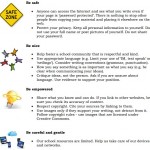We’ve been working and editing our Digital Citizenship (curriculum dare I say) for a bit now (squeezed in between all the other projects). And I’ve returned to the same conclusion I had at the beginning of this journey. The only thing that is really different is that we access an online environment (switching back and forth like a dynamo). If we dig a bit deeper, we’d see the beliefs are nothing more than the values we already have in our face-to-face world. Values like we respect each other, we respect ourselves and because of that, our actions show it in how we treat both ourselves and others.
The online world has something that our face-to-face world doesn’t have – the ability to communicate and collaborate worldwide in a matter of seconds. This is what social media is all about. Immediacy of connections. And that is where some of the issues may pop up. Once that little publish button, tweet, text or Instagram is posted, it cannot be pulled back. The danger lies in the immediacy – no thinking required. Thinking happened when you were writing (or perhaps not). This leads some to say, just block the tools. However, by using technology to block is to give away teachable moments. A powerful opportunity exists to teach students the ‘what, why, how, where’ of digital citizenship, before, during and after such events.  These interactions help build the ‘realness’ of online behaviours and attitudes. In essence, they showcase the true values of each of us. What do we really believe? How do we reflect that in our voice, in our actions, in our learning and growing over time? Are there places where our students can learn and practice these skills?
These interactions help build the ‘realness’ of online behaviours and attitudes. In essence, they showcase the true values of each of us. What do we really believe? How do we reflect that in our voice, in our actions, in our learning and growing over time? Are there places where our students can learn and practice these skills?
We synthesized these down to four areas – Be safe, Be nice, Be empowered, Be Careful.
You can find the full document here.
Social media is here to stay. Digital interactions will increase as people find more uses for it in our daily lives. What we do to answer the questions posed and how we support the digital social learning process is paramount. It is not about the tool. Perhaps the better filter is not an automated one, but one where the student thoughtfully asks: who do I want to be to this global world?
I’d be interested in any thoughts you may have on how you’re negotiating this world with your students or staffs.